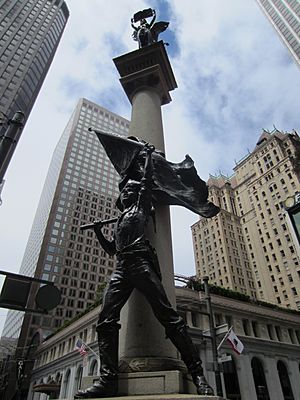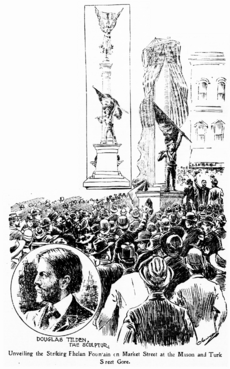Admission Day Monument facts for kids

The Admission Day Monument in 2013
|
|
| Coordinates | 37°47′21″N 122°24′07″W / 37.78909°N 122.40184°W |
|---|---|
| Location | Market Street and Montgomery Street in San Francisco, California, United States |
| Designer | Douglas Tilden |
| Type | sculpture |
| Material |
|
| Completion date | 1897 |
The Admission Day Monument is a cool sculpture made by Douglas Tilden in 1897. You can find it in San Francisco, California, where Market Street and Montgomery Street meet. This monument celebrates a very important day: California Admission Day. This was on September 9, 1850, when California officially became a state in the United States, after the Mexican-American War.
This sculpture has a few other names too, like Admission Day, Admission Day Fountain, California Admissions Day Monument, and Native Sons' Monument.
Contents
History of the Admission Day Monument
The monument was ordered by Mayor James D. Phelan. He paid $12,000 for it, which was a lot of money back then! The mayor wanted a beautiful place for people to get a drink of water.
Mayor Phelan officially offered the monument to the city on February 8, 1896. The city leaders, called the Board of Supervisors, accepted his generous gift. They even named it the Phelan Fountain at first.
The monument was officially shown to the public on September 5, 1897. It was dedicated to a group called the Native Sons of the Golden West on September 9, 1897. This group celebrates California's history. Mayor Phelan wanted a simple ceremony without big speeches or parades.
In 1948, the monument was moved to Golden Gate Park. But in 1977, it was brought back to Market Street. The Native Sons group helped make this happen.
What Does the Admission Day Monument Look Like?
When it was first put up, the monument stood on a large square base. It had three steps leading up to a stone stand. On top of this stand was a tall pillar, and then the bronze sculptures. The whole monument was about 35 feet tall, which is like a three-story building! When it was moved back to Market Street in the 1970s, the steps and base were not put back. So now, it's a little shorter, about 33.5 feet tall.
The Miner Sculpture
At the bottom, there's a bronze sculpture of a miner. He's waving an American flag and carrying a gun. This miner represents the young people of California or the Native Sons of the Golden West. He looks excited and proud. He also has a miner's pickaxe over his shoulder.
The Genius of California
Above the miner, on top of the tall pillar, stands another bronze figure. This is called the Genius of California. It's a woman who looks like the sculptor's wife. She is blessing the union of California with the rest of the country. She stands on a bronze ball and holds an open book. Inside the book, you can see the date: September 9, 1850. This is the day California became a state. Each of these bronze figures is about 7 feet tall.
The Base and Fountain
The base of the monument was designed by Willis Polk. It has two bronze bear heads. Water used to come out of their mouths! These bear heads are surrounded by snakes. The snakes represent the Sierra Nevada mountains and the challenges of living in the wild West.
Originally, you could pull handles between the bears' teeth. This would release water from the snakes' heads into cups. People could drink from these cups, which were decorated with buffalo designs.
There's also a quote carved into the base. It's from a speech by William H. Seward from 1850. He said, "The perpetual unity of the Empire hangs on the decision of this day." This quote means that California joining the U.S. was very important for the country's future.
On another side of the base, there's a dedication. It says the fountain is for the Native Sons of the Golden West. It celebrates California joining the Union on September 9, 1850.
The Admission Day Monument in Stories
The Native Sons' monument even appeared in a fun children's story in 1898. It was called "The Three Fountains" and was published in the San Francisco Call newspaper.
In the story, two characters named Sinbad and the Lob-Lolly are exploring San Francisco. Sinbad gets thirsty, and the Lob-Lolly calls over another fountain, Lotta's Fountain. Lotta's Fountain gives out cold soda water! When it starts to run low, it goes to the Native Sons' monument for help. The Native Sons' monument then gives soda to the girls. The boys are sent to another fountain, the Cogswell Fountain. But instead of soda, the Cogswell Fountain gives them something that tastes like castor oil!



